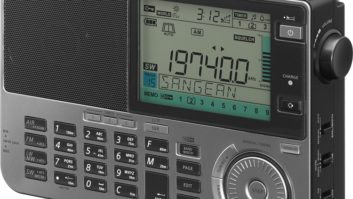It’s no secret that media consumption habits are changing rapidly and that online listening is on the rise. Recent research conducted jointly by Edison Research and Triton Digital fills in some of the blanks and gives numbers to these and other trends. The report also has implications for station managers who are developing strategic plans and creating budgets for the coming years.
“The Infinite Dial 2015” is the latest in a long-running series of studies about consumer adoption of digital media. Possibly the biggest takeaway from the study is that this past year was when online listening reached critical mass.
“For years Americans have been occasional listeners, but for the first time it’s apparent that streaming audio has become an ingrained part of our lives as the number of Americans listening weekly is now 44 percent,” said John Rosso, president of Market Development for Triton Digital. “This is a huge opportunity for publishers and marketers to better identify and target their listeners to maximize ad-based revenue.”
ONLINE LISTENING
Starting in 2000, just 5 percent of the population aged 12 and older listened to online radio monthly (whether to Internet-only stations or to the online streams of over-the-air broadcasters). That number has grown until estimates for 2015 place the number at 53 percent, or 143 million Americans.
Not surprisingly, that number is skewed towards younger listeners, with 77 percent in the age 12–24 demographic listening monthly, 61 percent 25–54 and just 26 percent age 55+.

This graph shows the steady increase in online listening since 2000; over the course of the past 15 years, there has been an increase of 48 percent of respondents who say that they stream radio at least monthly.
The devices used to listen to online radio have changed dramatically over the years as well. Much of the early listening to online radio was done either through a PC’s external speakers or with Internet-connected appliances, such as the Logitech Slimplayer.
But times have changed. Today, smartphones are far and away the device most used to listen to Internet streams, and 73 percent of users access them using mobile devices. Desktops and laptops are a close second with 61 percent. Internet-connected audio systems bring up the rear, with only 3 percent of listeners using them. And that Logitech Slimplayer? Long gone.
Missing from “The Infinite Dial 2015” is any information about metadata, the artist/song title, sports scores, promotional information and emergency alerts that appears as text in the RDS display of FM radio, as program service data on HD Radios and on Web streams.
Do listeners pay attention to metadata? Does it matter? Tom Webster, vice president of strategy and marketing for Edison Research, said, “This is one of those things we poll regularly, but not every year. The last time it was surveyed, respondents characterized metadata as very important.”
AUTO PREFERENCES
Online radio listening in the car environment is increasing but has yet to reach the tipping point. When asked, “Have you ever listened to Internet radio in a car by listening to the stream from a cell phone that you have connected to a car audio system,” 35 percent said yes in 2015, up from 21 percent in 2013. Again, the largest component, over half, are in the 12–24 demographic.
AM/FM radio still has a commanding place in the automotive environment, although its influence is declining.

AM/FM has maintained supremacy for music discovery — but by a considerably slimmer margin than in the past. As more streamers and other music aggregators appear on the scene, consumers continue to turn to friends and family for music updates. YouTube and Pandora also continue to be on many listeners’ radar.
When asked how often they use a given medium in their primary car, 53 percent said most of the time they use AM/FM radio; that’s down from 58 percent for the past two years. Fifteen percent prefer an MP3 player with their own music. Bringing up the rear are CD players with 11 percent, satellite radio with 10 percent and online radio with 9 percent.
Despite this gradual shift in listening preferences, interest in in-dash information and entertainment systems appears to be lukewarm. When asked how important it is that their next car has an in-dash system that enables reception of information and entertainment over the Internet, 41 percent said not important at all, while 24 percent said not very important. Just 15 percent responded very important.
KEEPING UP WITH TRENDS
Respondents are divided as to the importance of keeping up with new music and releases.
Among the total sample, 51 percent felt that it was not important at all, while 33 percent noted it was somewhat important, and just 16 percent that said it was very important.
Among those who say it is somewhat or very important, AM/FM radio still leads with 29 percent. That number changes dramatically when the 12–24 demographic is polled. Then AM/FM radio draws just 8 percent.
BRAND AWARENESS
The series of questions about audio branding yielded some predictable results.
Subjects were asked, “When thinking about Internet-only audio, what is the first word that comes to mind?” The overwhelming response was Pandora, from 75 percent of respondents; iTunes and iHeartRadio came in second and third, with 62 and 59 percent respectively. The survey also showed moderate gains in weekly listening to Pandora, Spotify, iTunes and iHeartRadio when compared to last year.
Missing from the survey is information about how much time listeners spend with streams from local media vs. national brands. Webster said, “That type of information is surveyed for a different report, which is only available to subscribers.”
PODCASTS
Podcasting has also seen a significant increase in listenership. Beginning with individuals recording in closet studios to minuscule audiences, podcasts have become mainstreamed, drawing the attention of big media. The recent launch of Play.it by CBS has provided a focal point for many popular serialized podcasts.

Mobile devices, like smartphones and tablets, play up the mobility of podcasts. Podcast apps also facilitate listening on these devices. However, computers still have a strong foothold in this market, perhaps in part because many podcast users chose to stream, rather than download, episodes.
The researchers have tracked the growth of podcasting, starting with 9 percent listening monthly in 2008 to 17 percent, or about 46 million today. Respondents listened to an average of six podcasts per week. Serialized podcasts however seem to be on the trailing edge. The survey indicated that only 10 percent of respondents were aware of serialized podcasts, and only 3 percent have ever listened to one.
THE BOTTOM LINE
The study is likely to be a discussion point at this month’s NAB convention. What will managers of traditional stations take from it that can be applied to budgeting and strategic planning?
While stations have been streaming for a number of years, online audio has never quite gotten beyond second-class status for many of them, whose attention and resources remain directed towards terrestrial signals. As online listening is reaching parity with over-the-air listening, that position may no longer be tenable, though the question of whether online revenue justifies a broader transition remains an open one.
But these stations cannot compete head on with Pandora or iTunes, so how can they differentiate themselves and their product to gain a larger share of the online audience?
On the technical side, big players in online media have raised listener expectations. So audio processors tailored for online streams are becoming more important; with advances in coding algorithms and audio processing schemes, delivering a high-quality online stream is obtainable. Also, sufficient backup for 24/7/365 uptime for an audio stream becomes important.
Major-market broadcasters contemplating large online audiences may want to seek out the services of a content distribution network; notable brands include Akamai, Level3 and Arkena. They will manage both distribution of the stream and the gathering and reporting of statistics about online listenership. Will stations continue to move in these directions?
On the programming side, will online competition renew discussion of localism, one of the strengths of radio? Local traffic, news, weather, music and promotions remain strong characteristics of traditional radio operations, and offer to ways to differentiate a product from a biggie like Pandora as well as from online-only alternatives that are less well-resourced.
On-air personalities are another way that radio might strike back. As described by its critics — and many insiders as well — U.S. commercial radio has allowed a gradual de-emphasis of personalities from the dial. Many of the online giants are jukeboxes with little in the line of live presence. Will more managers differentiate their content with live personalities who know the community, its people and its events?
Radio has become an interactive medium. The challenge for managers is how to deliver the best possible experience for their listeners — be it on air, online or through social media. A big part of that experience is metadata. Many stations that do a stellar job of getting the text out along with the music on the radio side don’t do so well on their steams. A handful of companies sell hardware and software solutions that ensure metadata is distributed properly over terrestrial radio, online and on social media.
Podcasting presents opportunities extend localism onto the Net. “Artist interviews from morning shows can be podcast,” said Webster, “and interesting content from other programs can be chopped up and repurposed.” He adds that listeners with special interests may be another source for podcast material for local stations.
How should radio managers react to the data in this study? Email [email protected] with Letter to the Editor in the subject field.
The “Infinite Dial 2015” is the 23rd in a series of studies about consumer adoption of digital media dating to 1998; it used a random probability telephone sample representative of Americans age 12 and older. The survey was offered in both English and Spanish. Both landlines and cell phone numbers were called. The survey was conducted in January and February 2015 and surveyed 2,002 people.
Tom Vernon is a longtime contributor to Radio World. Find more of his articles by searching keyword “Vernon” onradioworld.com.










